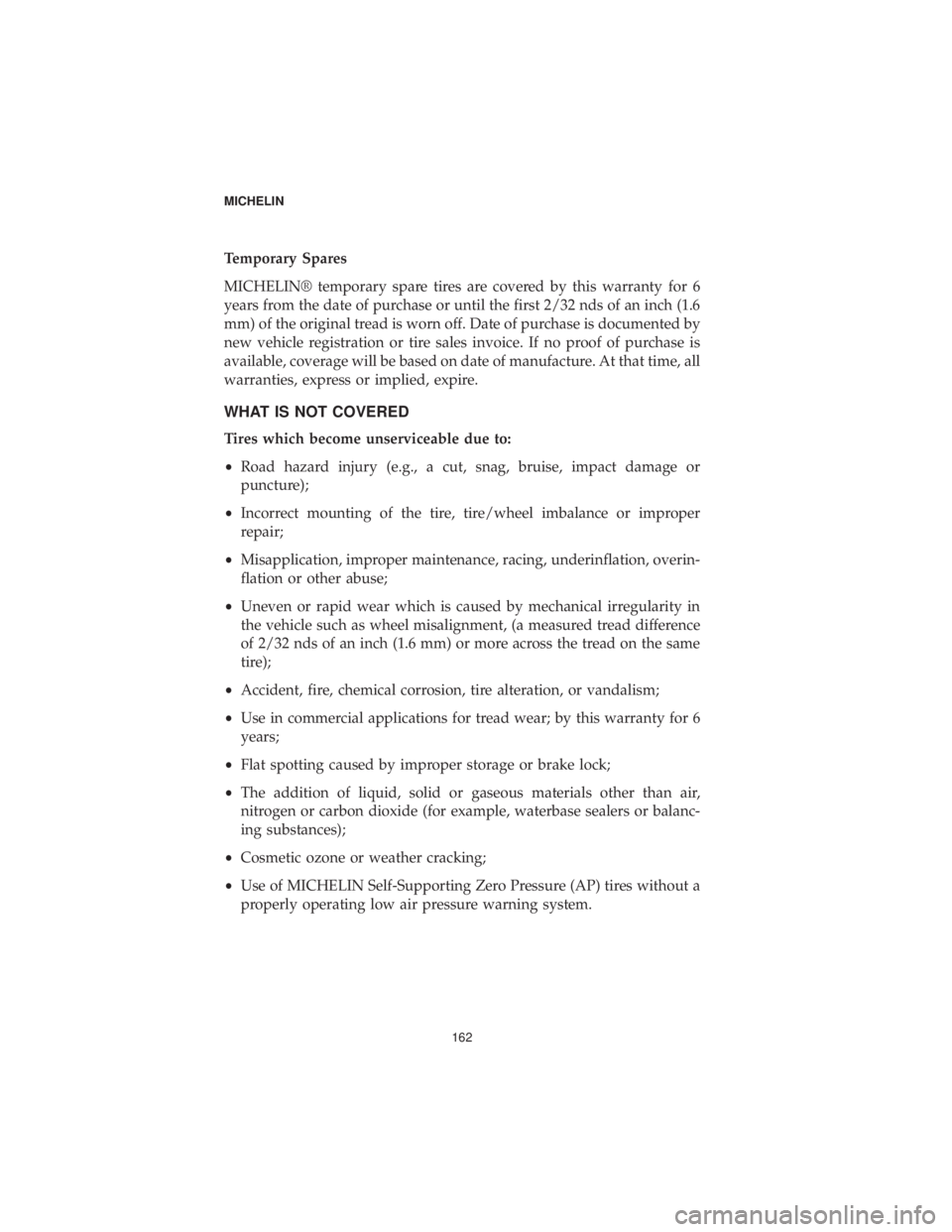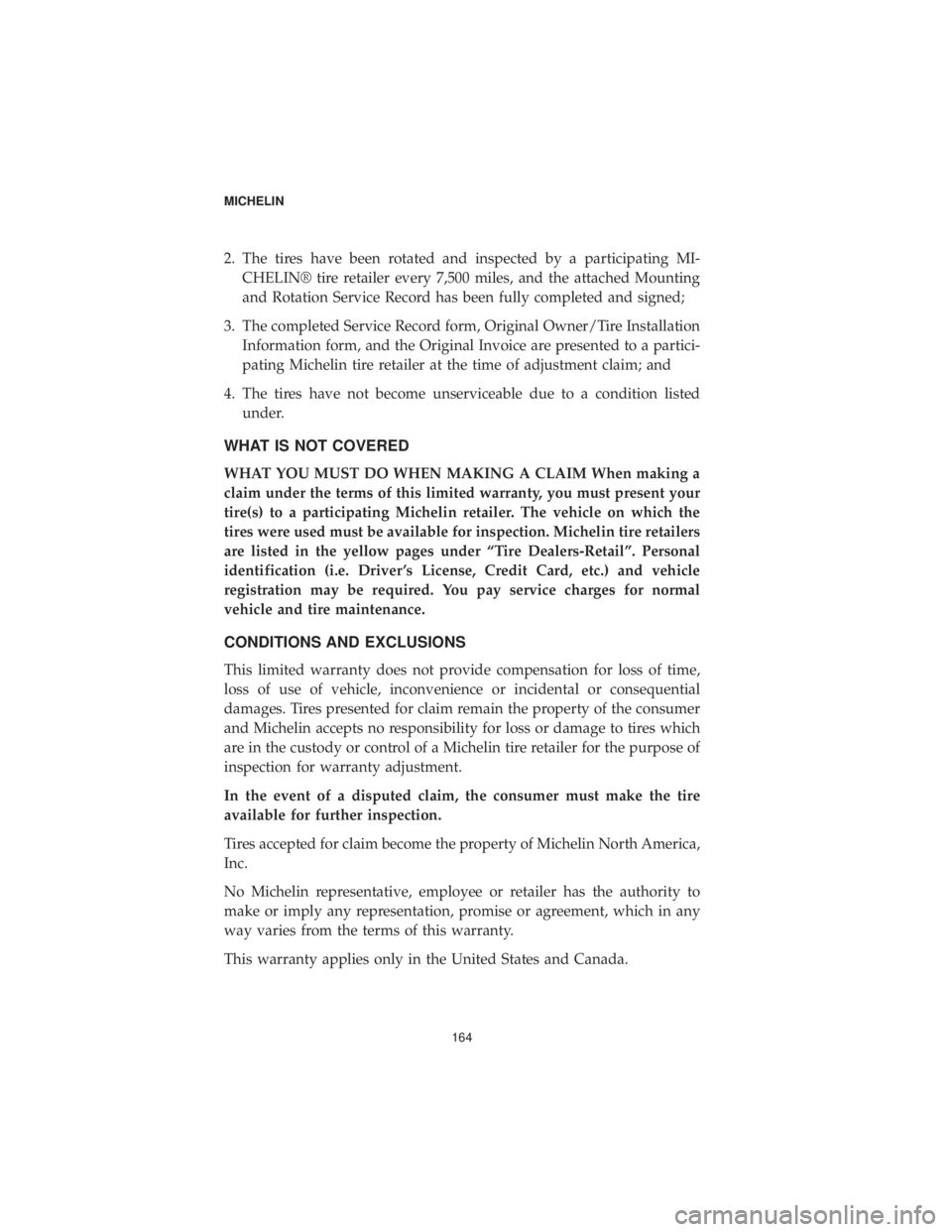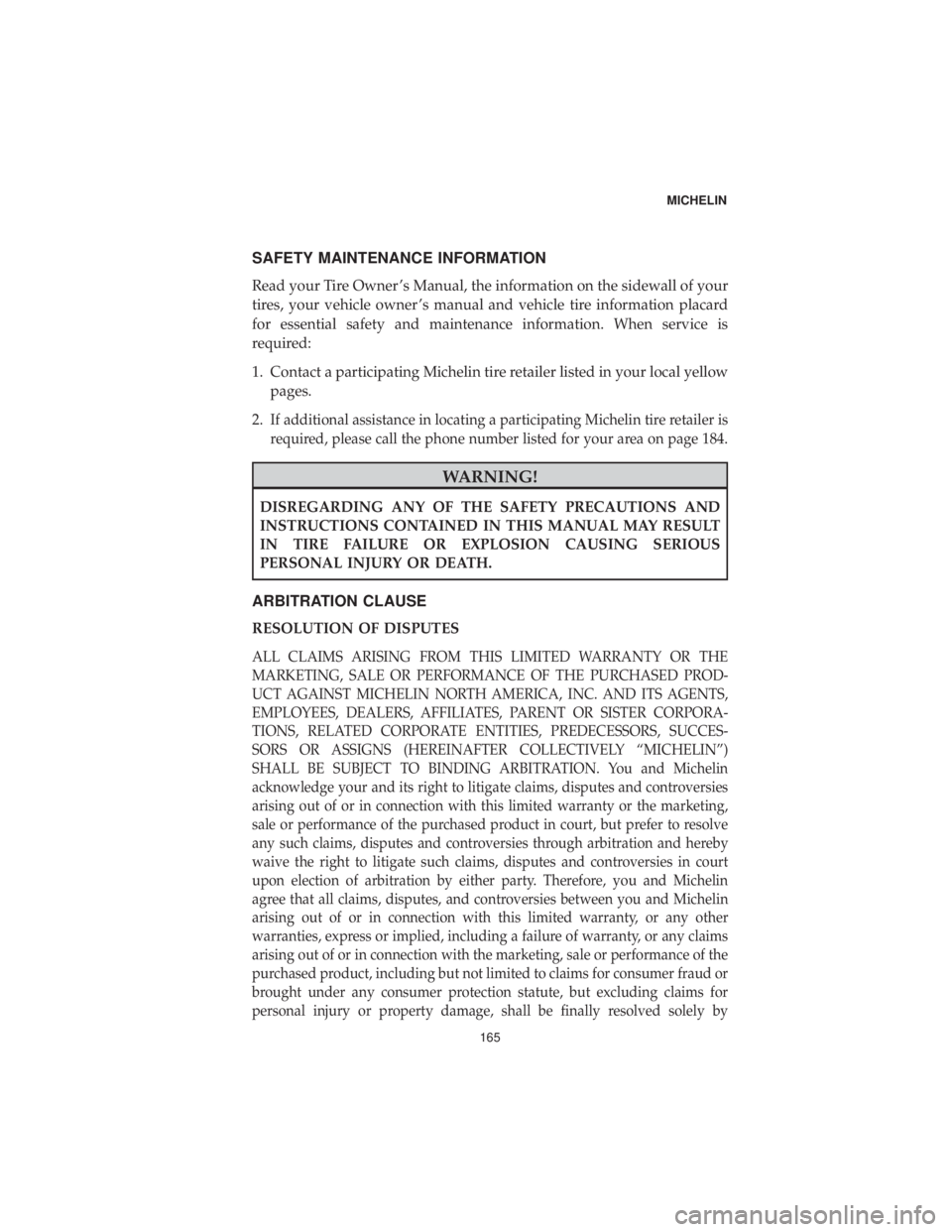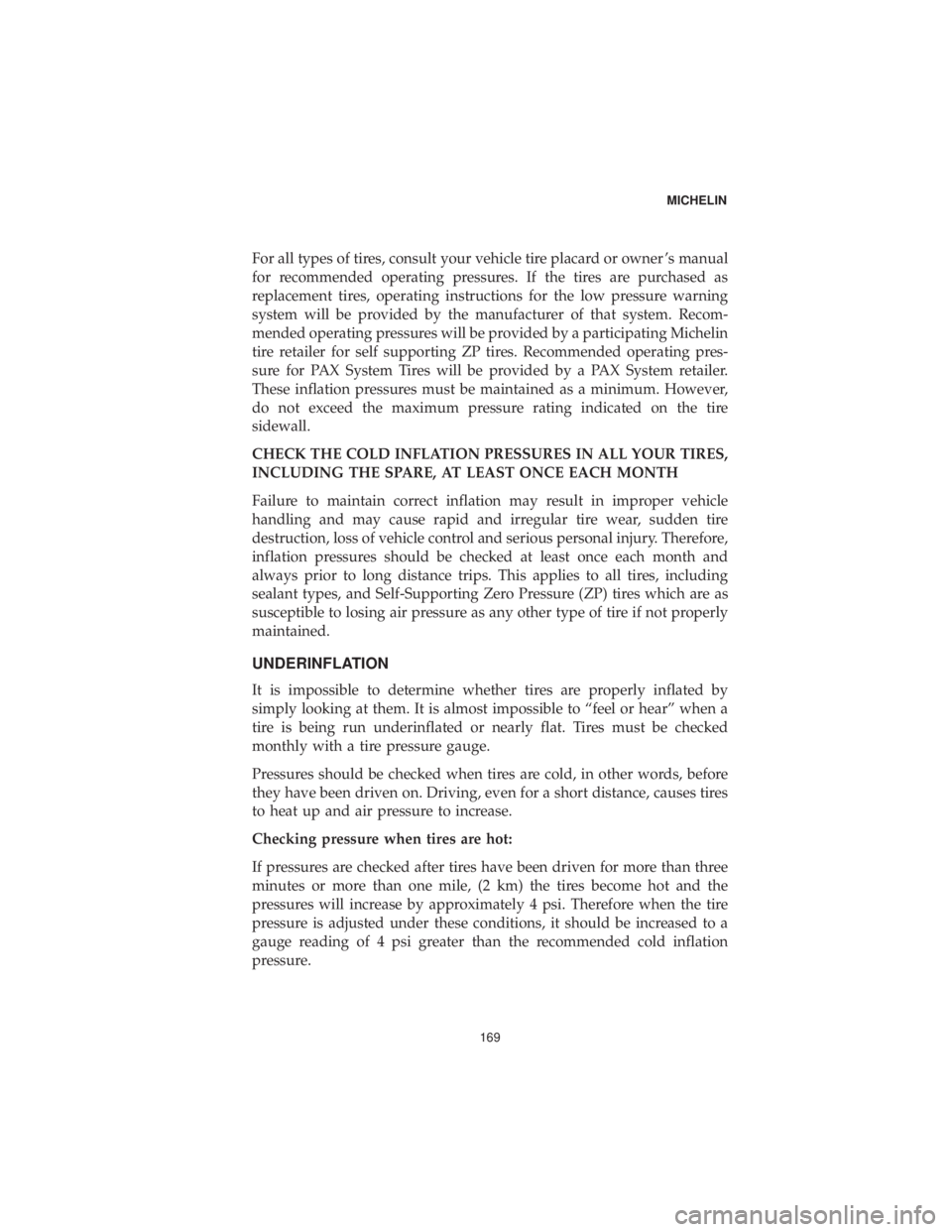2019 DODGE DURANGO SRT tires
[x] Cancel search: tiresPage 162 of 270

NOTE:your vehicle manufacturer may provide additional tire warranty
coverage over and above what is provided by Michelin. Consult your
vehicle owner ’s manual for further information.
NOTE: Some MICHELIN® Self-Supporting Zero Pressure (ZP) tires can
only be mounted on special SH-M (Symmetric Hump - Modified) wheels.
These tires bear the special SH-M designation, molded into the sidewall
of the tire, next to the ZP designation. DO NOT MOUNT A TIRE WITH
THE SH-M DESIGNATION ON THE SIDEWALL ON A STANDARD
WHEEL. DOING SO VOIDS THIS LIMITED WARRANTY AND COULD
CAUSE THE TIRE TO BECOME UNSERVICEABLE AT LOW OR ZERO
PRESSURE, RESULTING IN SERIOUS PERSONAL INJURY OR DEATH.
Treadwear – Mileage Warranty Coverage for MICHELIN® Passenger
and Light Truck Tires
MICHELIN® passenger and light truck tires are covered by a manufac-
turer ’s limited warranty for treadwear. For the mileage warranty associ-
ated with a specific tire line, please see your Michelin tire retailer or visit
us at
www.michelinman.com/promise. Some vehicles come from the
vehicle manufacturer with “split fitments” – meaning different size tires
on the front and rear axles. Because these tires cannot be rotated as
recommended by Michelin, the mileage warranty on each rear tire will
cover half the number of miles as the standard mileage warranty for that
particular tire design. Michelin Self-Supporting Zero Pressure (ZP) tires
have the same mileage warranty as the standard tire line of which they
are a part, up to but not exceeding 30,000 miles. DOT-approved compe-
tition tires (e.g., MICHELIN® Pilot® Sport Cup tires) are excluded from
any mileage warranty. MICHELIN® Winter tires must be used during
winter months only, defined as a period beginning on or after September
1st of a given year and ending no later than April 30th of the following
year. MICHELIN winter tires require documentation of the timing of the
installation and removal of the tires each winter to maintain coverage
under the limited warranty for treadwear.
An important reminder:
No tire manufacturer can guarantee you a certain number of miles from
a given tire. Driving habits, driving conditions, road conditions, and
vehicle maintenance all play a part in the tread life of a tire. If a tire does
not reach the warranted mileage, and the owner of the tires has complied
with the terms and conditions of the warranty, Michelin will replace the
tires as described under “How Replacement Charges are calculated”.
MICHELIN
161
Page 163 of 270

Temporary Spares
MICHELIN® temporary spare tires are covered by this warranty for 6
years from the date of purchase or until the first 2/32 nds of an inch (1.6
mm) of the original tread is worn off. Date of purchase is documented by
new vehicle registration or tire sales invoice. If no proof of purchase is
available, coverage will be based on date of manufacture. At that time, all
warranties, express or implied, expire.
WHAT IS NOT COVERED
Tires which become unserviceable due to:
•Road hazard injury (e.g., a cut, snag, bruise, impact damage or
puncture);
• Incorrect mounting of the tire, tire/wheel imbalance or improper
repair;
• Misapplication, improper maintenance, racing, underinflation, overin-
flation or other abuse;
• Uneven or rapid wear which is caused by mechanical irregularity in
the vehicle such as wheel misalignment, (a measured tread difference
of 2/32 nds of an inch (1.6 mm) or more across the tread on the same
tire);
• Accident, fire, chemical corrosion, tire alteration, or vandalism;
• Use in commercial applications for tread wear; by this warranty for 6
years;
• Flat spotting caused by improper storage or brake lock;
• The addition of liquid, solid or gaseous materials other than air,
nitrogen or carbon dioxide (for example, waterbase sealers or balanc-
ing substances);
• Cosmetic ozone or weather cracking;
• Use of MICHELIN Self-Supporting Zero Pressure (AP) tires without a
properly operating low air pressure warning system.
MICHELIN
162
Page 164 of 270

HOW REPLACEMENT CHARGES ARE CALCULATED
Passenger and Light Truck Tires
A tire which becomes unserviceable due to a condition covered by this
workmanship and materials limited warranty will be replaced with a
comparable new MICHELIN® tire, free of charge, when 2/32 nds of an
inch (1.6 mm) or less of the original tread is worn, (or 25% or less,
whichever is more beneficial to the user) and within 12 months of the
date of purchase. Mounting and balancing of the tire is included.You pay
the cost of any other service charges and applicable taxes. When more
than 2/32 nds of an inch (1.6 mm) of original tread has been worn (or
more than 25%, whichever is more beneficial to the user) or after 12
months from the date of purchase, you must pay the cost of a comparable
new MICHELIN® passenger or light truck replacement tire on a pro rata
basis. The retailer will determine the charge by multiplying the percent-
age of the original usable tread worn, by the current selling price at the
adjustment location or the price in the current MICHELIN® Base Price
List, whichever is lower. This list is based on a predetermined price
intended to fairly represent the actual selling price of the tire. You pay the
cost of mounting, balancing and any other service charges and appli-
cable taxes.
Treadwear
A tire meeting the conditions for pro rata replacement, which wears evenly
across the tread, down to the tread wear indicators (2/32nds of an inch
tread remaining) within 6 years of the date of purchase, and before
delivering the warranted miles of service, will be replaced with a compa-
rable new MICHELIN® tire based on mileage received. The participating
MICHELIN® tire retailer will determine the charge by multiplying the
percent of mileage received by the current actual selling price at the
adjustment location or the price of the tire in the current Michelin Base Price
List, whichever is lower. This list is based on a predetermined price
intended to fairly represent the actual selling price of the tire. You pay the
cost of mounting, balancing and any other dealer services and applicable
taxes. Tires which wear out evenly before delivering the warranted mileage
will be replaced on a pro rata basis only if:
1. You are the original purchaser of the tires, you own the vehicle on which they were originally installed, and the tires have been used only
on that vehicle;
MICHELIN
163
Page 165 of 270

2. The tires have been rotated and inspected by a participating MI-CHELIN® tire retailer every 7,500 miles, and the attached Mounting
and Rotation Service Record has been fully completed and signed;
3. The completed Service Record form, Original Owner/Tire Installation Information form, and the Original Invoice are presented to a partici-
pating Michelin tire retailer at the time of adjustment claim; and
4. The tires have not become unserviceable due to a condition listed under.
WHAT IS NOT COVERED
WHAT YOU MUST DO WHEN MAKING A CLAIM When making a
claim under the terms of this limited warranty, you must present your
tire(s) to a participating Michelin retailer. The vehicle on which the
tires were used must be available for inspection. Michelin tire retailers
are listed in the yellow pages under “Tire Dealers-Retail”. Personal
identification (i.e. Driver ’s License, Credit Card, etc.) and vehicle
registration may be required. You pay service charges for normal
vehicle and tire maintenance.
CONDITIONS AND EXCLUSIONS
This limited warranty does not provide compensation for loss of time,
loss of use of vehicle, inconvenience or incidental or consequential
damages. Tires presented for claim remain the property of the consumer
and Michelin accepts no responsibility for loss or damage to tires which
are in the custody or control of a Michelin tire retailer for the purpose of
inspection for warranty adjustment.
In the event of a disputed claim, the consumer must make the tire
available for further inspection.
Tires accepted for claim become the property of Michelin North America,
Inc.
No Michelin representative, employee or retailer has the authority to
make or imply any representation, promise or agreement, which in any
way varies from the terms of this warranty.
This warranty applies only in the United States and Canada.
MICHELIN
164
Page 166 of 270

SAFETY MAINTENANCE INFORMATION
Read your Tire Owner ’s Manual, the information on the sidewall of your
tires, your vehicle owner ’s manual and vehicle tire information placard
for essential safety and maintenance information. When service is
required:
1. Contact a participating Michelin tire retailer listed in your local yellowpages.
2.
If additional assistance in locating a participating Michelin tire retailer is
required, please call the phone number listed for your area on page
184.
WARNING!
DISREGARDING ANY OF THE SAFETY PRECAUTIONS AND
INSTRUCTIONS CONTAINED IN THIS MANUAL MAY RESULT
IN TIRE FAILURE OR EXPLOSION CAUSING SERIOUS
PERSONAL INJURY OR DEATH.
ARBITRATION CLAUSE
RESOLUTION OF DISPUTES
ALL CLAIMS ARISING FROM THIS LIMITED WARRANTY OR THE
MARKETING, SALE OR PERFORMANCE OF THE PURCHASED PROD-
UCT AGAINST MICHELIN NORTH AMERICA, INC. AND ITS AGENTS,
EMPLOYEES, DEALERS, AFFILIATES, PARENT OR SISTER CORPORA-
TIONS, RELATED CORPORATE ENTITIES, PREDECESSORS, SUCCES-
SORS OR ASSIGNS (HEREINAFTER COLLECTIVELY “MICHELIN”)
SHALL BE SUBJECT TO BINDING ARBITRATION. You and Michelin
acknowledge your and its right to litigate claims, disputes and controversies
arising out of or in connection with this limited warranty or the marketing,
sale or performance of the purchased product in court, but prefer to resolve
any such claims, disputes and controversies through arbitration and hereby
waive the right to litigate such claims, disputes and controversies in court
upon election of arbitration by either party. Therefore, you and Michelin
agree that all claims, disputes, and controversies between you and Michelin
arising out of or in connection with this limited warranty, or any other
warranties, express or implied, including a failure of warranty, or any claims
arising out of or in connection with the marketing, sale or performance of the
purchased product, including but not limited to claims for consumer fraud or
brought under any consumer protection statute, but excluding claims for
personal injury or property damage, shall be finally resolved solely by
MICHELIN
165
Page 168 of 270

CONTROLLABILITY
Controlling a vehicle when a tire failure occurs
If a tire failure occurs, you may hear a loud noise, feel a vibration, and/or
the vehicle may pull toward the side of the failed tire. If possible, step on
the accelerator momentarily to maintain forward momentum and ensure
vehicle control. It is most important that you DO NOT BRAKE OR
ABRUPTLY TURN THE STEERING WHEEL. Slowly remove your foot
from the accelerator and hold the steering wheel firmly while steering to
remain in your lane. Once the vehicle has slowed and is fully under
control, apply the brakes gently; safely pull over to the shoulder and
come to a stop. Inspect the tires. If one or more looks flat or low, shows
detachment or other damage, remove tire assembly and replace it with a
properly inflated spare. Bumps or bulges may indicate detachment
within the tire body and require inspection by a qualified tire technician.
DRIVING ON ANY TIRE THAT DOES NOT HAVE THE CORRECT
INFLATION PRESSURE IS DANGEROUS
Any underinflated tire builds up excessive heat that may result in sudden
tire destruction. If tires are supplied as original equipment, refer to the
tire decal on the vehicle (check vehicle and/or vehicle owner ’s manual
for decal location) for the recommended operating pressures. For replace-
ment tires, the correct inflation pressure will be provided by your tire
retailer; if not, refer to the vehicle decal.
These inflation pressures must be maintained as a minimum. However,
do not exceed the maximum pressure rating indicated on the tire
sidewall.
SELF-SUPPORTING TIRES. ZERO PRESSURE (ZP) TIRES, AND PAX
SYSTEM TIRES, AT LOW OR ZERO AIR PRESSURE
The handling characteristics of a vehicle with a deflated PAX System tire
or Self- Supporting Zero Pressure (ZP) tire (whether front or rear) are not
the same as those of a vehicle with normally inflated tires. Avoid high
speeds and hard cornering whenever a low pressure warning is acti-
vated.
MICHELIN
167
Page 169 of 270

Even a MICHELIN® PAX® System Tire or Self-Supporting Zero Pressure
(ZP) tire can build up excessive heat when run underinflated for an
extended period of time. The length of time and distance a PAX System
Tire/Self-Supporting Zero Pressure (ZP) tire will perform at low or zero
air pressure will depend upon the severity of the event causing air loss,
ambient temperature, speed at which the tire is operated, and the
conditions under which the tire is operated (i.e. hard braking, cornering
and other sharp maneuvers will greatly reduce the length of time the tire
can perform at low or zero air pressure.) Continuous use of an underin-
flated tire may lead to sudden tire destruction. If a tire at low or zero
pressure begins to vibrate or cause difficulty in vehicle handling, remove
the tire immediately and replace with the temporary spare. If Michelin®
PAX System Tire/Self-Supporting Zero Pressure (ZP) tires are supplied as
original equipment, refer to the vehicle owner ’s manual for complete
details on the low tire pressure warning system designed to alert you in
the event of a low pressure condition.
NOTE:MICHELIN® SELF-SUPPORTING ZERO PRESSURE (ZP)
TIRES ARE TO BE USED ONLY IN CONJUNCTION WITH AN OPERA-
TIONAL, MICHELIN® APPROVED, LOW TIRE PRESSURE WARNING
SYSTEM. Otherwise, all provisions of the limited warranty are void. For
a list of approved systems, see your participating Michelin® tire retailer,
or call toll free:1-800-847-3435
NOTE: Some MICHELIN® Self-Supporting Zero Pressure (ZP) tires can
only be mounted on special SH-M (Symmetric Hump - Modified) wheels.
These tires bear the special SH-M designation, molded into the sidewall
of the tire, next to the ZP designation. DO NOT MOUNT A TIRE WITH
THE SH-M DESIGNATION ON THE SIDEWALL ON A STANDARD
WHEEL. DOING SO VOIDS THIS LIMITED WARRANTY AND COULD
CAUSE THE TIRE TO BECOME UNSERVICEABLE AT LOW OR ZERO
PRESSURE, RESULTING IN SERIOUS PERSONAL INJURY OR DEATH.
NOTE: MICHELIN® PAX® SYSTEM TIRES ARE TO BE USED ONLY
IN CONJUNCTION WITH AN OPERATIONAL, TIRE PRESSURE
MONITORING SYSTEM (TPMS), APPROVED BY THE VEHICLE
MANUFACTURER FOR USE WITH THE PAX SYSTEM. Otherwise, all
provisions of the limited warranty are void. For a list of approved
systems, see your authorized PAX System retailer, or call toll free:
1-877-PAX TIRE or 1-877-729-8473
MICHELIN
168
Page 170 of 270

For all types of tires, consult your vehicle tire placard or owner ’s manual
for recommended operating pressures. If the tires are purchased as
replacement tires, operating instructions for the low pressure warning
system will be provided by the manufacturer of that system. Recom-
mended operating pressures will be provided by a participating Michelin
tire retailer for self supporting ZP tires. Recommended operating pres-
sure for PAX System Tires will be provided by a PAX System retailer.
These inflation pressures must be maintained as a minimum. However,
do not exceed the maximum pressure rating indicated on the tire
sidewall.
CHECK THE COLD INFLATION PRESSURES IN ALL YOUR TIRES,
INCLUDING THE SPARE, AT LEAST ONCE EACH MONTH
Failure to maintain correct inflation may result in improper vehicle
handling and may cause rapid and irregular tire wear, sudden tire
destruction, loss of vehicle control and serious personal injury. Therefore,
inflation pressures should be checked at least once each month and
always prior to long distance trips. This applies to all tires, including
sealant types, and Self-Supporting Zero Pressure (ZP) tires which are as
susceptible to losing air pressure as any other type of tire if not properly
maintained.
UNDERINFLATION
It is impossible to determine whether tires are properly inflated by
simply looking at them. It is almost impossible to “feel or hear” when a
tire is being run underinflated or nearly flat. Tires must be checked
monthly with a tire pressure gauge.
Pressures should be checked when tires are cold, in other words, before
they have been driven on. Driving, even for a short distance, causes tires
to heat up and air pressure to increase.
Checking pressure when tires are hot:
If pressures are checked after tires have been driven for more than three
minutes or more than one mile, (2 km) the tires become hot and the
pressures will increase by approximately 4 psi. Therefore when the tire
pressure is adjusted under these conditions, it should be increased to a
gauge reading of 4 psi greater than the recommended cold inflation
pressure.
MICHELIN
169